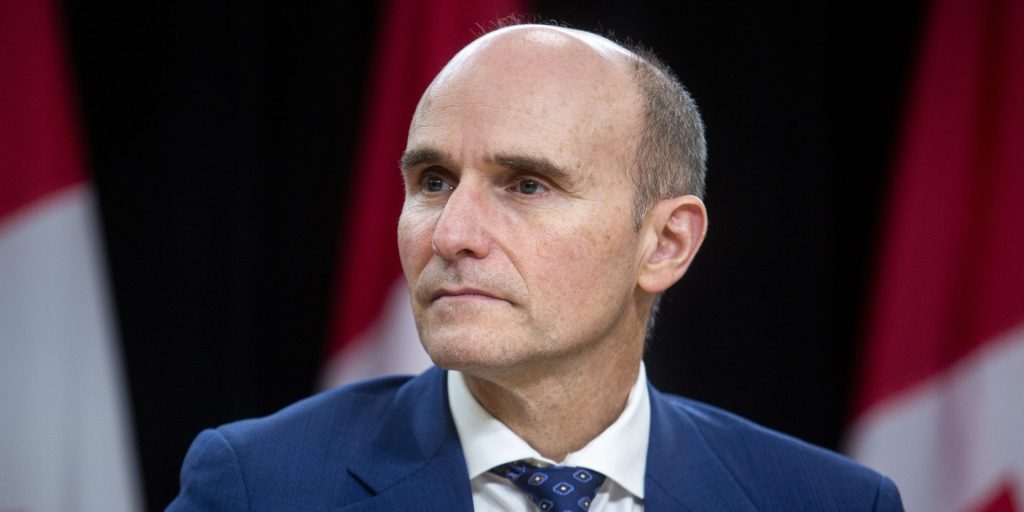Books, Big Ideas, Q&As
A different ‘philosophy’ steers new drug pricing guidelines, says top PMPRB bureaucrat after contentious path to rule changes

Eight years after the Trudeau Liberals pledged to lower pharmaceutical prices through new rules, and three years after those rules officially launched, the Patented Medicine Prices Review Board has released guidelines to help it monitor prices under the modified regulatory regime.
The federal government announced in 2017 it would change the way prices were regulated in this country through amendments to the Patented Medicines Regulations. This was in response to Canada’s status as having the third-highest prices in the world for medicines.
These changes require the participation of the Patented Medicine Prices Review Board (PMPRB), an “independent quasi-judicial” body that falls under the federal health portfolio, but is meant to be an arm’s-length entity from the government. The PMPRB, whose mandate is defined under the Patent Act, exists to review the prices of drugs that are sold in Canada, and to ensure that they are not excessive.
In order to apply the new rules, the PMPRB has to produce guidelines that outline exactly how it would do so through its monitoring practices.
Both the implementation of the rules and the development of guidelines were subject to fierce opposition, controversy, and many delays due to legal challenges and the COVID-19 pandemic.
Four legal challenges—two initial filings and two appeals—were brought forward by the pharmaceutical industry, and were heard both in Quebec and at the Federal Court between 2019 and 2022. The courts ultimately ruled that the government was acting outside of its jurisdiction in trying to implement some of the new rules, but said a plan to update a list of comparator countries could go ahead. The PMPRB uses this list to see how the price of a drug in Canada fares against that same drug’s price in the countries on its list.
The new list of comparator nations—which no longer includes the United States, where drug prices are higher than those here—came into effect on July 1, 2022, two years after the rule was supposed to come into play.

But controversy continued following a series of resignations between December 2022 and February 2023 by the acting chair, a PMPRB board member, and executive director Douglas Clark. Matthew Herder, a now former board member who is also a health law professor, posted his resignation letter on X on Feb. 23, 2023, citing his reasons for leaving as the government’s lack of support for its policy changes and interference by then-health minister Jean-Yves Duclos (Québec Centre, Que.) in the independent guidelines process.
The internal problems at the PMPRB motivated a House health committee study in spring 2023. The committee’s May 2024 report recommended that the federal government should “implement a clear communications protocol” between the health minister and PMPRB board members.
In April 2023, Guillaume Couillard replaced Clark as the PMPRB’s top bureaucrat where he holds the title of director general. That same year saw the entry of a new set of board members who led yet another consultation process with the goal of finally producing guidelines to accompany the rules that were implemented in July 2022. The board has been using its 2010 guidelines in the meantime.
The 2025 guidelines will be in use starting for “new” medicines (those first sold in Canada after the rules were implemented in July 2022) in January 2026, and “old” drugs (those sold before July 2022) in January 2028.
Couillard, who initially joined the PMPRB in 2014, spoke to The Hill Times about the new guidelines and the PMPRB’s mandate.
The following interview has been edited for length, style, and clarity.
As you came into the PMPRB’s leadership role, amid all of the attention on the organization … what was important to you as you started talking with the pharma companies again?
“I’m the director general, so I’m [responsible for] the daily operation. When it comes to the guidelines, it belongs to the board itself. … The 2025 guidelines, and the philosophy is completely different … In 2010, it was a gatekeeping exercise. So, a drug was coming into the country, the PMPRB would do a full analysis of the drugs based on Sec. 85 of the [Patent] Act, which is the excessive pricing factors, and then would establish a ceiling. And then the board would monitor that. … Every single drug had to go through the process, and it was taking some time in order to publish pricing.
“The 2025 guidelines are completely different. … So, instead of doing a 100-per-cent gatekeeping review using all the factors … the staff will do two steps. Step one would be an initial review, and the only thing we do is we look at the international [prices] and look at the Canadian price. If the Canadian price is lower than the highest international price (HIP) of the basket of 11 [comparator countries], it’s a pass. … If at initial review, you’re above the HIP, then you go into an in-depth review, and this is where we would look at all the factors under Section 85.”
The guidelines have streamlined the process for the pharmaceutical sector, but how does it strike the balance of protecting Canadians from excessive prices versus making pharma companies’ lives a bit easier?
“The Patented Medicine Prices Review Board’s mandate is to monitor price. It’s not to set [prices], it’s not to regulate; it’s to monitor pricing and intervene only where there’s potentially a problem. … So, in establishing triggers through the HIP or the [Consumer Price Index or CPI], it enables the PMPRB to focus its resources only where there’s potentially a problem.”

I want to jump to one of the guidelines about the idea that if there are no international prices to compare to, the company is considered to have passed the initial review. You told The Globe and Mail that it was to entice companies to launch medicines in Canada first. Why is it the PMPRB’s job to encourage firms to launch medicines in Canada first?
“The PMPRB is not a barrier to entry. So, one thing that is misunderstood about our mandate is that [drug companies] need authorization of the PMPRB to sell into Canada. …[In actuality,] they sell [their drug], and then we look as to whether the price is excessive or not. …However, if there are no prices to compare yourself to, and your company decides to launch into Canada first, well, they would not be subject to an in-depth review. That doesn’t mean they won’t be subject to an in-depth review in three years or four years, when there’ll be more countries [where they’re selling], but it could be an incentive, potentially, for the companies to come into Canada first, because they know they don’t have to worry about the PMPRB until they start selling in other countries.”
I know it’s just one guideline of many, but how big of a part of the thought process was that? I appreciate your comment about the PMPRB not being a barrier to entry, but it’s also not ISED. It’s not its job to sell Canada to pharmaceutical companies.
“I guess what the board did is look at Section 85, look at the factors. They’ve decided that the international comparison would [be] the trigger. What do you do if there is no comparison? Well, I guess you cannot do the comparison. And therefore, it’s all about the mandate, right? It’s all about how we do monitor [and] where do we allocate resources?”
It sounds like, in the past, the PMPRB would do random monitoring of medicines, and that’s going to change. I read you’re going to step away from that, and put the onus on federal and provincial ministers of health and representatives of public drug plans to launch complaints. Why is it up to politicians or their bureaucrats to bring problems to the agency’s attention if it’s the PMPRB’s job to monitor drug prices?
“[We conduct] an annual review [of] each single drug we look at, and then we look at whether it’s above HIP or CPI. Now, guidelines are meant to be general, so if there’s some specific problem, it’s very difficult for the PMPRB to notice. We’re not buying [the drugs], we’re not reimbursing; our job is to monitor pricing. Therefore the complaint mechanism of payers is a system that the board has decided to put in place in case we miss something.”
The guidelines and the PMPRB’s 2025-26 departmental plan emphasize the board’s need to keep its resources in mind. The guidelines talk about the possibility of sending deferral letters to the manufacturers if PMPRB resources are constrained, while the plan says the PMPRB has limited capacity to hold hearings. But this work seems to be a core part of the PMPRB’s mandate. Why are resources such an issue?
(Editor’s Note: The PMPRB’s 2025-26 plan shows that the board spent between $12-million and $14-million in each of the last three fiscal years, and that it will have an annual budget of approximately $18.1-million for the fiscal years between 2025-26 and 2027-28. A spokesperson for the PMPRB told The Hill Times by email on July 16 that the board’s funding has remained stable in recent years. The lower spending figures between 2022-23 and 2024-25 are due to the board not having to use funding allocated for hearings with pharmaceutical companies because there weren’t any hearings.)
“We have a budget. There are 1,200 [or] 1,300 [drug identification numbers]. So, that’s why the guidelines are directed at staff as to where to allocate their time and resources. … So [with] the 2010 guidelines, we were doing a lot of the work up front, and a lot of the time we were spending time and resources on cases where there were absolutely no issues. By having triggers in place where we can focus on cases where it’s most likely there’s potentially some issues … this is where we can focus on resources. Obviously, when [the first in-effect date of] Jan. 1, 2026, comes, there’ll be kind of an influx of potentially new cases. This is why we reserve the right to use deferral letters [for reviews] because we have limited resources. But over time, we believe that post-2028, when the older drugs are going to come into play, we’ll be fine.”
Health Canada has been modernizing its regulatory process since 2017. The Liberals’ 2025 election platform stated that one of their priorities would be reducing the amount of time it takes to access medicines. The PMPRB is an independent body, but are these regulatory changes something your agency has been keeping in mind as it builds a plan for reviewing medicine prices?
We have no role to play on access. … What the PMPRB does—and the courts were clear about that—is we monitor what’s going on and then intervene if there’s an issue of excessive pricing. … [Imagine that] we’re sitting on the highway watching traffic go by, and if someone is going way too fast, we may stop that person and ask a few questions. Because when we’re [conducting] an in-depth review, it’s not a conclusion. We just say, ‘Why are you going fast? Is there a valid reason to go that fast?’ That’s the best way I can [put] it. So, we’re not in charge of the highway per se—to build the highway or to provide access to the highway.
You said earlier, ‘We are not a regulator. We monitor.’ You’re a government-funded body that reviews and monitors prices. Are you not regulating them?
“We review and monitor pricing. The Quebec Court of Appeal and the Federal Court have been pretty clear on what we are and what we’re not, so basically, the board has respected what the courts have said about us, and this is why they launched the new guidelines. Plus the fact that we had new countries. You combine these two things plus … a new board [and] this is why we started fresh with a new consultation that lasted 18 months. So, we do review pricing every year, we do monitor pricing, we intervene where there’s potential excessiveness, but we are not an industry regulator.”
tsanci@hilltimes.com
The Hill Times






 LICENSING
LICENSING PODCAST
PODCAST ALERTS
ALERTS













